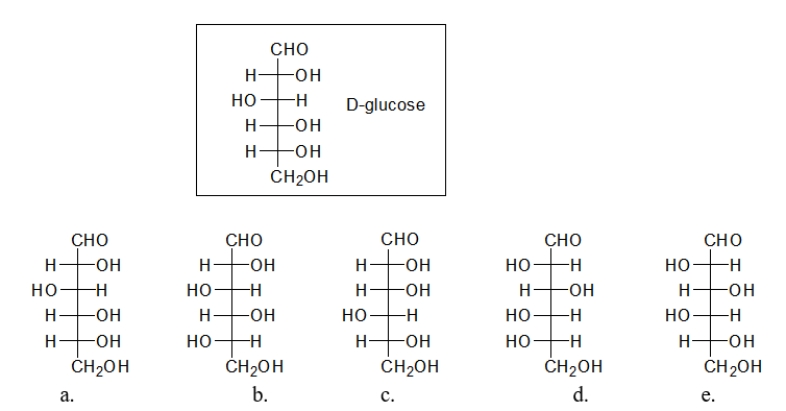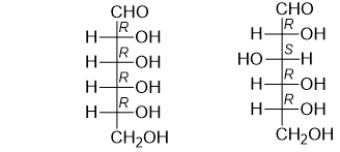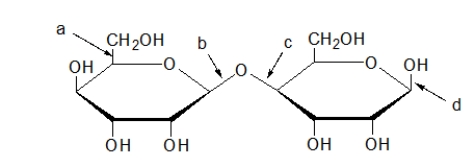A) structure a
B) structure b
C) structure c
D) structure d
E) structure e
G) B) and E)
Correct Answer

verified
Correct Answer
verified
Multiple Choice
Cellulose and starch are similar in that they are both polymers of glucose.Cellulose, however, forms sheet-like structures, which give rigidity to a plant, whereas starch forms spirals.What accounts for this difference in macroscopic structure?
A) Cellulose is composed of D-glucose, whereas starch is composed of L-glucose.
B) Cellulose and starch are connected together on different carbons.
C) Cellulose is composed of L-glucose, whereas starch is composed of D-glucose.
D) Cellulose has a β-(1→4) linkage, whereas starch has an α-(1→4) linkage.
E) Starch has a β-(1→4) linkage, whereas cellulose has an α-(1→4) linkage.
G) B) and C)
Correct Answer

verified
Correct Answer
verified
Multiple Choice
A racemic mixture is
A) a 50:50 mixture of enantiomers.
B) optically active.
C) a pure sample of a single enantiomer.
D) dextrorotatory.
E) indicated by the IUPAC prefix R.
G) A) and B)
Correct Answer

verified
Correct Answer
verified
Multiple Choice
D-glucose is shown below.Which of the choices below is L-glucose? 
A) sugar a
B) sugar b
C) sugar c
D) sugar d
E) sugar e
G) A) and C)
Correct Answer

verified
Correct Answer
verified
Multiple Choice
Which of the following blood types can be donated to someone with type A blood?
A) type A only
B) type A or type O
C) type A or type AB
D) any of the blood types except A
E) Type A can receive blood from any of the blood types.
G) A) and B)
Correct Answer

verified
Correct Answer
verified
Multiple Choice
Which glycosidic linkage does the sugar shown below contain? 
A) β-(2→4)
B) α-(1→4)
C) β-(1→4)
D) α-(2→4)
E) α-(2→6)
G) B) and D)
Correct Answer

verified
Correct Answer
verified
Multiple Choice
Select the species present in higher concentration at equilibrium in aqueous solution. 
A) I
B) II
C) III
D) II and III
E) There are equal concentrations of these three species in solution.
G) A) and D)
Correct Answer

verified
Correct Answer
verified
Multiple Choice
The result of a patient's fasting plasma glucose test is 60 mg glucose per deciliter.This patient is
A) normal.
B) hypoglycemic.
C) hyperglycemic.
D) diabetic.
E) both hyperglycemic and diabetic.
G) C) and D)
Correct Answer

verified
Correct Answer
verified
Multiple Choice
What is the relationship between the two molecules shown? 
A) identical molecules
B) isomers
C) enantiomers
D) conformations
E) diastereomers
G) A) and D)
Correct Answer

verified
Correct Answer
verified
Multiple Choice
Which statement BEST describes how a cell distinguishes between a host cell and foreign cell?
A) Antibodies detect foreign cells.
B) This is what T-cells do.
C) Oligosaccharide cell markers on the surface of the cell do this.
D) A cell sends out special proteins to do this.
E) The proteins within the cell membrane do this.
G) B) and E)
Correct Answer

verified
Correct Answer
verified
Multiple Choice
What is the relationship between the two molecules shown? 
A) identical molecules
B) isomers
C) enantiomers
D) conformations
E) diastereomers
G) A) and E)
Correct Answer

verified
Correct Answer
verified
Multiple Choice
Which of the following is NOT a function of carbohydrates?
A) Carbohydrates are used for long-term energy storage.
B) Carbohydrates are fuels for cells.
C) Carbohydrates are part of DNA and RNA.
D) Carbohydrates are used in cellular recognition.
E) Carbohydrates make some foods taste sweet.
G) C) and E)
Correct Answer

verified
Correct Answer
verified
Multiple Choice
Which disaccharide is found in milk?
A) lactose
B) sucrose
C) cellobiose
D) maltose
E) both cellobiose and maltose
G) A) and E)
Correct Answer

verified
Correct Answer
verified
Multiple Choice
Which of the following molecules is NOT a polysaccharide?
A) amylose
B) amylopectin
C) cellulose
D) glycogen
E) glucose
G) A) and D)
Correct Answer

verified
Correct Answer
verified
Multiple Choice
Which arrow is pointing to a glycosidic bond? 
A) a only
B) b only
C) c only
D) b and c
E) b, c, and d
G) A) and E)
Correct Answer

verified
Correct Answer
verified
Multiple Choice
Which of the following classes of biomolecules causes dental caries?
A) carbohydrates
B) proteins
C) fats
D) nucleic acids
E) All foods cause dental caries.
G) B) and E)
Correct Answer

verified
Correct Answer
verified
Multiple Choice
The most common polysaccharides found in plants and animals are polymers of
A) galactose.
B) glucose.
C) fructose.
D) glucose and fructose.
E) glucose, fructose, and galactose.
G) None of the above
Correct Answer

verified
Correct Answer
verified
Multiple Choice
Which one of these molecules is a naturally occurring sugar?
A) ![]()
B) ![]()
C) ![]()
D) ![]()
E) ![]()
G) A) and C)
Correct Answer

verified
Correct Answer
verified
Multiple Choice
Only one of the following molecules is a naturally occurring sugar.Which statement is a reason that only one of the sugars is naturally occurring? 
A) Naturally occurring sugars do not have multiple hydroxyl groups on a single carbon.
B) D-sugars are much more common than L-sugars.
C) Naturally occurring sugars are polyhydroxylated.
D) Naturally occurring sugars contain a carbonyl.
E) All of the above are true statements.
G) A) and D)
Correct Answer

verified
Correct Answer
verified
Multiple Choice
How are disaccharides separated into two monosaccharides?
A) It is not possible to separate disaccharides into monosaccharides.
B) by esterification
C) by hydration
D) by hydrolysis
E) by amidation
G) B) and C)
Correct Answer

verified
Correct Answer
verified
Showing 21 - 40 of 97
Related Exams